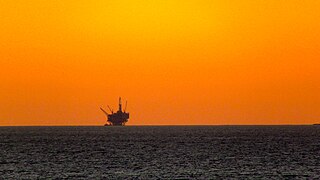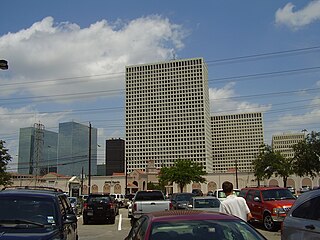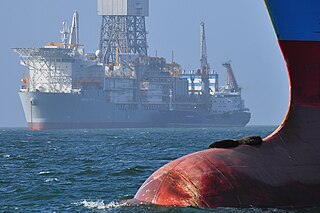
An oil platform, offshore platform, or offshore drilling rig is a large structure with facilities for well drilling to explore, extract, store, and process petroleum and natural gas that lies in rock formations beneath the seabed. Many oil platforms will also contain facilities to accommodate their workforce. Most commonly, oil platforms engage in activities on the continental shelf, though they can also be used in lakes, inshore waters, and inland seas. Depending on the circumstances, the platform may be fixed to the ocean floor, consist of an artificial island, or float. Remote subsea wells may also be connected to a platform by flow lines and by umbilical connections. These sub-sea solutions may consist of one or more subsea wells or of one or more manifold centres for multiple wells.

An oil well is a boring in the Earth that is designed to bring petroleum oil hydrocarbons to the surface. Usually some natural gas is released as associated petroleum gas along with the oil. A well that is designed to produce only gas may be termed a gas well.
An oil rig is any kind of apparatus constructed for oil drilling.

A rigger boot is a particular type of pull-on safety boot in the United Kingdom. The name "rigger" comes from the fact that they were standard issue for workers on the offshore oil rigs in the North Sea, but are nowadays worn by most types of manual worker as a general purpose workboot.

Roughneck is a term for a person whose occupation is hard manual labor. The term applies across a number of industries, but is most commonly associated with the workers on a drilling rig. The ideal of the hard-working, tough roughneck has been adopted by several sports teams who use the phrase as part of their name or logo.

A drilling rig is an integrated system that drills wells, such as oil or water wells, in the earth's subsurface. Drilling rigs can be massive structures housing equipment used to drill water wells, oil wells, or natural gas extraction wells, or they can be small enough to be moved manually by one person and such are called augers. Drilling rigs can sample subsurface mineral deposits, test rock, soil and groundwater physical properties, and also can be used to install sub-surface fabrications, such as underground utilities, instrumentation, tunnels or wells. Drilling rigs can be mobile equipment mounted on trucks, tracks or trailers, or more permanent land or marine-based structures. The term "rig" therefore generally refers to the complex equipment that is used to penetrate the surface of the Earth's crust.

Transocean Ltd. is the world's largest offshore drilling contractor based on revenue and is based in Vernier, Switzerland. The company has offices in 20 countries, including Canada, the United States, Norway, Scotland, India, Brazil, Singapore, Indonesia, and Malaysia.

Byford Dolphin is a semi-submersible, column-stabilised drilling rig operated by Dolphin Drilling, a Fred Olsen Energy subsidiary, and in 2009 contracted by BP for drilling in the United Kingdom section of the North Sea for three years. It is registered in Hamilton, Bermuda.
Petrobras 36 (P-36) was at the time the largest floating semi-submersible oil platform in the world prior to its sinking on 20 March 2001. It was owned by Petrobras, a semi-public Brazilian oil company headquartered in Rio de Janeiro. The cost of the platform was US$350 million.

Valaris plc is an offshore drilling contractor headquartered in Houston, Texas, and incorporated in the UK. It is the largest offshore drilling and well drilling company in the world, and owns 74 rigs, including 50 offshore jackup rigs, 16 drillships, and 8 semi-submersible platform drilling rigs.
Essar Shipping Ltd., now Essar Shipping Ports & Logistics Limited, is an Indian shipping corporation for the global energy business. The company is a part of Essar Group. It was started in 1945 and incorporated in 2010. The company is listed in Bombay Stock Exchange BSE: 500630. The company headquarters is located in Mumbai.

Offshore drilling is a mechanical process where a wellbore is drilled below the seabed. It is typically carried out in order to explore for and subsequently extract petroleum which lies in rock formations beneath the seabed. Most commonly, the term is used to describe drilling activities on the continental shelf, though the term can also be applied to drilling in lakes, inshore waters and inland seas.

Deepwater Horizon was an ultra-deepwater, dynamically positioned, semi-submersible offshore drilling rig owned by Transocean. Built in 2001 in South Korea by Hyundai Heavy Industries, the rig was commissioned by R&B Falcon, registered in Majuro, and leased to BP from 2001 until September 2013. In September 2009, the rig drilled the deepest oil well in history at a vertical depth of 35,050 ft (10,683 m) and measured depth of 35,055 ft (10,685 m) in the Tiber Oil Field at Keathley Canyon block 102, approximately 250 miles (400 km) southeast of Houston, in 4,132 feet (1,259 m) of water.

A heavy-lift ship is a vessel designed to move very large loads that cannot be handled by normal ships. They are of two types:
Deepwater drilling, or Deep well drilling, is the process of creating holes by drilling rig for oil mining in deep sea. There are approximately 3400 deepwater wells in the Gulf of Mexico with depths greater than 150 meters.

The U.S. offshore drilling debate is an ongoing debate in the United States on whether or not, the extent to which, in which areas, and under what conditions, further offshore drilling should be allowed in U.S.-administered waters.

The Macondo Prospect is an oil and gas prospect in the United States Exclusive Economic Zone of the Gulf of Mexico, off the coast of Louisiana. The prospect was the site of the Deepwater Horizon drilling rig explosion in April 2010 that led to a major oil spill in the region.

The Deepwater Horizon drilling rig explosion was the April 20, 2010, explosion and subsequent fire on the Deepwater Horizon semi-submersible mobile offshore drilling unit, which was owned and operated by Transocean and drilling for BP in the Macondo Prospect oil field about 40 miles (64 km) southeast off the Louisiana coast. The explosion and subsequent fire resulted in the sinking of the Deepwater Horizon and the deaths of 11 workers; 17 others were injured. The same blowout that caused the explosion also caused an oil well fire and a massive offshore oil spill in the Gulf of Mexico, considered the largest accidental marine oil spill in the world, and the largest environmental disaster in U.S. history.

The North Dakota oil boom refers to the period of rapidly expanding oil extraction from the Bakken formation in the state of North Dakota that lasted from the discovery of Parshall Oil Field in 2006, and peaked in 2012, but with substantially less growth noted since 2015 due to a global decline in oil prices. Despite the Great Recession, the oil boom resulted in enough jobs to provide North Dakota with the lowest unemployment rate in the United States from 2008 to at least 2014. The boom gave North Dakota, a state with a 2013 population of about 725,000, a billion-dollar budget surplus. North Dakota, which ranked 38th in per capita gross domestic product (GDP) in 2001, rose steadily with the Bakken boom, and had a per capita GDP 29% above the national average by 2013.

The Petroleum Museum is a museum in Canada Hill, Miri, Sarawak, Malaysia.














